托福高分心得之阅读成绩如何快速提高
- 格式:doc
- 大小:19.75 KB
- 文档页数:11
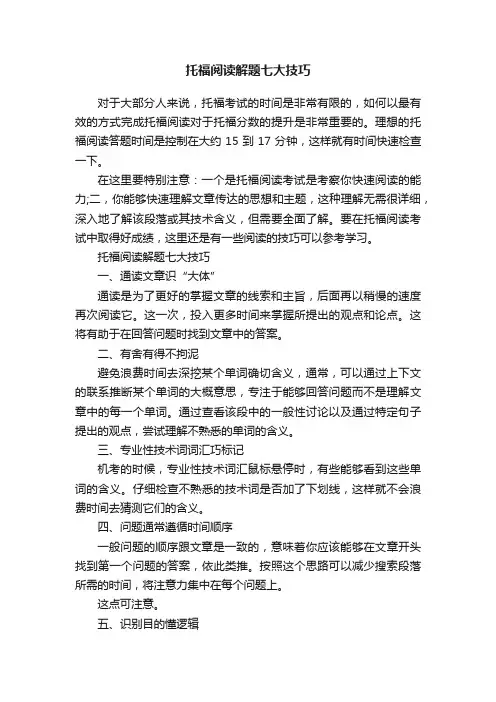
托福阅读解题七大技巧对于大部分人来说,托福考试的时间是非常有限的,如何以最有效的方式完成托福阅读对于托福分数的提升是非常重要的。
理想的托福阅读答题时间是控制在大约15到17分钟,这样就有时间快速检查一下。
在这里要特别注意:一个是托福阅读考试是考察你快速阅读的能力;二,你能够快速理解文章传达的思想和主题,这种理解无需很详细,深入地了解该段落或其技术含义,但需要全面了解。
要在托福阅读考试中取得好成绩,这里还是有一些阅读的技巧可以参考学习。
托福阅读解题七大技巧一、通读文章识“大体”通读是为了更好的掌握文章的线索和主旨,后面再以稍慢的速度再次阅读它。
这一次,投入更多时间来掌握所提出的观点和论点。
这将有助于在回答问题时找到文章中的答案。
二、有舍有得不拘泥避免浪费时间去深挖某个单词确切含义,通常,可以通过上下文的联系推断某个单词的大概意思,专注于能够回答问题而不是理解文章中的每一个单词。
通过查看该段中的一般性讨论以及通过特定句子提出的观点,尝试理解不熟悉的单词的含义。
三、专业性技术词词汇巧标记机考的时候,专业性技术词汇鼠标悬停时,有些能够看到这些单词的含义。
仔细检查不熟悉的技术词是否加了下划线,这样就不会浪费时间去猜测它们的含义。
四、问题通常遵循时间顺序一般问题的顺序跟文章是一致的,意味着你应该能够在文章开头找到第一个问题的答案,依此类推。
按照这个思路可以减少搜索段落所需的时间,将注意力集中在每个问题上。
这点可注意。
五、识别目的懂逻辑在阅读时,要线理解这篇文章的目的是什么,是涉及因果关系,对比,分类,提出问题及其解决方案,或者是叙述。
了解这一点可以让您更轻松地遵循通道中的逻辑思维流程,从而简化快速定位答案的过程。
六、快慢结合切忌太快很多考生犯的一个常见错误就是读得太快,错过了问题中“不”或“除外”等关键词。
先阅读问题,然后重新阅读文章,以避免这些错误。
忽略过渡词会导致理解意思上发生大的偏差。
七、最后一题多总结最后一个问题通常要求你理解这篇文章所传达的主要思想和总结性的。
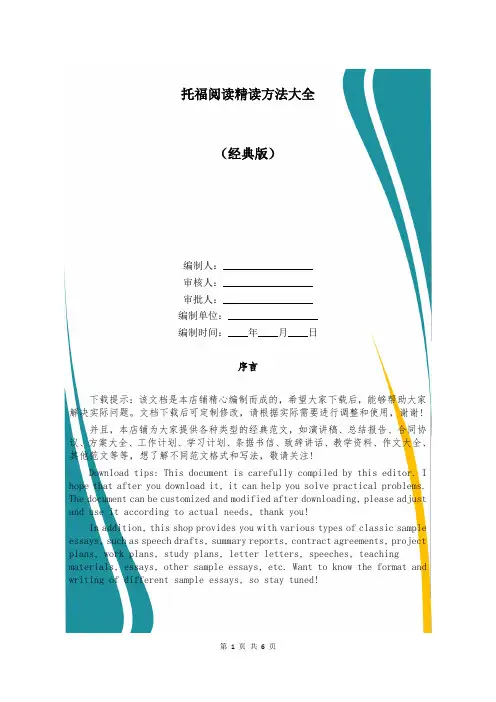
托福阅读精读方法大全(经典版)编制人:__________________审核人:__________________审批人:__________________编制单位:__________________编制时间:____年____月____日序言下载提示:该文档是本店铺精心编制而成的,希望大家下载后,能够帮助大家解决实际问题。
文档下载后可定制修改,请根据实际需要进行调整和使用,谢谢!并且,本店铺为大家提供各种类型的经典范文,如演讲稿、总结报告、合同协议、方案大全、工作计划、学习计划、条据书信、致辞讲话、教学资料、作文大全、其他范文等等,想了解不同范文格式和写法,敬请关注!Download tips: This document is carefully compiled by this editor. I hope that after you download it, it can help you solve practical problems. The document can be customized and modified after downloading, please adjust and use it according to actual needs, thank you!In addition, this shop provides you with various types of classic sample essays, such as speech drafts, summary reports, contract agreements, project plans, work plans, study plans, letter letters, speeches, teaching materials, essays, other sample essays, etc. Want to know the format and writing of different sample essays, so stay tuned!托福阅读精读方法大全托福阅读满分的秘诀是精读托福文章!所谓的精读就是快速把握文章中的重要信息和内容,准确提高对字词,句篇的分析能力和解读能力,下面本店铺给大家分享一些托福阅读精读方法。
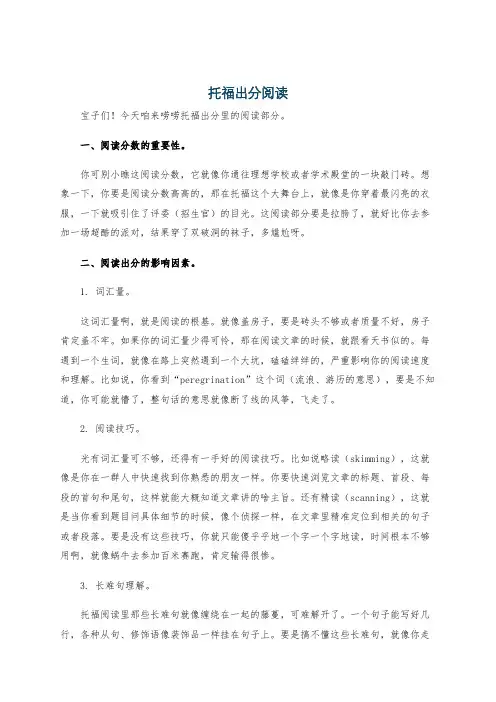
托福出分阅读宝子们!今天咱来唠唠托福出分里的阅读部分。
一、阅读分数的重要性。
你可别小瞧这阅读分数,它就像你通往理想学校或者学术殿堂的一块敲门砖。
想象一下,你要是阅读分数高高的,那在托福这个大舞台上,就像是你穿着最闪亮的衣服,一下就吸引住了评委(招生官)的目光。
这阅读部分要是拉胯了,就好比你去参加一场超酷的派对,结果穿了双破洞的袜子,多尴尬呀。
二、阅读出分的影响因素。
1. 词汇量。
这词汇量啊,就是阅读的根基。
就像盖房子,要是砖头不够或者质量不好,房子肯定盖不牢。
如果你的词汇量少得可怜,那在阅读文章的时候,就跟看天书似的。
每遇到一个生词,就像在路上突然遇到一个大坑,磕磕绊绊的,严重影响你的阅读速度和理解。
比如说,你看到“peregrination”这个词(流浪、游历的意思),要是不知道,你可能就懵了,整句话的意思就像断了线的风筝,飞走了。
2. 阅读技巧。
光有词汇量可不够,还得有一手好的阅读技巧。
比如说略读(skimming),这就像是你在一群人中快速找到你熟悉的朋友一样。
你要快速浏览文章的标题、首段、每段的首句和尾句,这样就能大概知道文章讲的啥主旨。
还有精读(scanning),这就是当你看到题目问具体细节的时候,像个侦探一样,在文章里精准定位到相关的句子或者段落。
要是没有这些技巧,你就只能傻乎乎地一个字一个字地读,时间根本不够用啊,就像蜗牛去参加百米赛跑,肯定输得很惨。
3. 长难句理解。
托福阅读里那些长难句就像缠绕在一起的藤蔓,可难解开了。
一个句子能写好几行,各种从句、修饰语像装饰品一样挂在句子上。
要是搞不懂这些长难句,就像你走进了一个迷宫,转来转去出不来。
比如说这个句子:“The concept of'environment' is difficult to understand, not only because it is so complex and all encompassing, but also because the word itself has so manydifferent connotations in different contexts.”(“环境”这个概念很难理解,不仅因为它如此复杂和包罗万象,还因为这个词本身在不同语境中有很多不同的内涵。
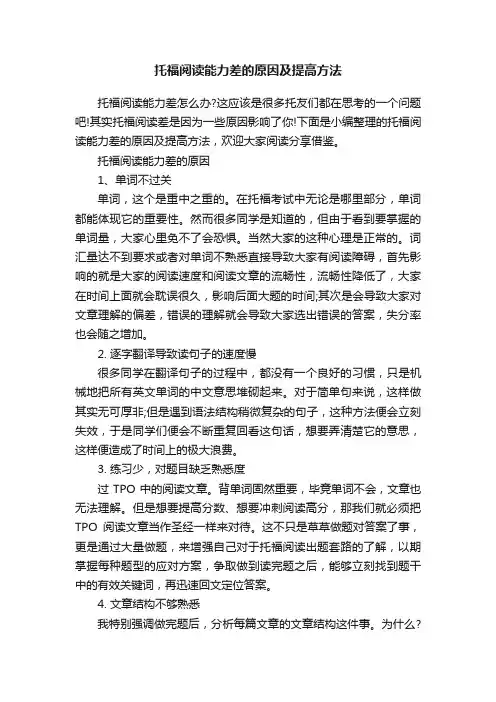
托福阅读能力差的原因及提高方法托福阅读能力差怎么办?这应该是很多托友们都在思考的一个问题吧!其实托福阅读差是因为一些原因影响了你!下面是小编整理的托福阅读能力差的原因及提高方法,欢迎大家阅读分享借鉴。
托福阅读能力差的原因1、单词不过关单词,这个是重中之重的。
在托福考试中无论是哪里部分,单词都能体现它的重要性。
然而很多同学是知道的,但由于看到要掌握的单词量,大家心里免不了会恐惧。
当然大家的这种心理是正常的。
词汇量达不到要求或者对单词不熟悉直接导致大家有阅读障碍,首先影响的就是大家的阅读速度和阅读文章的流畅性,流畅性降低了,大家在时间上面就会耽误很久,影响后面大题的时间;其次是会导致大家对文章理解的偏差,错误的理解就会导致大家选出错误的答案,失分率也会随之增加。
2. 逐字翻译导致读句子的速度慢很多同学在翻译句子的过程中,都没有一个良好的习惯,只是机械地把所有英文单词的中文意思堆砌起来。
对于简单句来说,这样做其实无可厚非;但是遇到语法结构稍微复杂的句子,这种方法便会立刻失效,于是同学们便会不断重复回看这句话,想要弄清楚它的意思,这样便造成了时间上的极大浪费。
3. 练习少,对题目缺乏熟悉度过TPO中的阅读文章。
背单词固然重要,毕竟单词不会,文章也无法理解。
但是想要提高分数、想要冲刺阅读高分,那我们就必须把TPO阅读文章当作圣经一样来对待。
这不只是草草做题对答案了事,更是通过大量做题,来增强自己对于托福阅读出题套路的了解,以期掌握每种题型的应对方案,争取做到读完题之后,能够立刻找到题干中的有效关键词,再迅速回文定位答案。
4. 文章结构不够熟悉我特别强调做完题后,分析每篇文章的文章结构这件事。
为什么?因为文章结构大概也就那么几种,见得多了,便就一见如故了。
文章的结构是有单词、句子、段落组成的,每个组成部分都会有逻辑性,对文章结构的不熟悉也是就是没有顺清逻辑,会导致大家在看文章没有连惯性。
托福阅读能力提高方法1、词汇量的达标前文已经提到单词如果不达标会出现的情况,所以单词量必须要达到要求!大家在课余时间加强对单词、词组的记忆,在做练习时大家就会发现文章中的词汇多样化很多,而且一些专业性的单词也较多,不仅要对基本词汇的记忆,也要对高级词汇和专业性词汇的记忆。
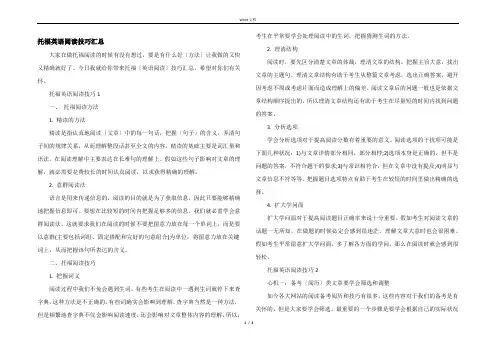
托福英语阅读技巧汇总大家在做托福阅读的时候有没有想过,要是有什么好〔方法〕让我做的又快又精确就好了。
今日我就给你带来托福〔英语阅读〕技巧汇总,希望对你们有关怀。
托福英语阅读技巧1一、托福阅读方法1. 精读的方法精读是指认真地阅读〔文章〕中的每一句话,把握〔句子〕的含义,弄清句子间的规律关系,从而理解整段话甚至全文的内容。
精读的基础主要是词汇量和语法。
在阅读理解中主要表达在长难句的理解上。
假如这些句子影响对文章的理解,就必需要花费较长的时间认真阅读,以求获得精确的理解。
2. 意群阅读法语言是用来传递信息的,阅读的目的就是为了获取信息,因此只要能够精确地把握信息即可。
要想在比较短的时间内把握足够多的信息,我们就必需学会意群阅读法。
这就要求我们在阅读的时候不要把留意力放在每一个单词上,而是要以意群(主要包括词组、固定搭配和完好的句意组合)为单位,将留意力放在关键词上,从而把握该句所表达的含义。
二、托福阅读技巧1. 把握词义阅读过程中我们不免会遇到生词,有些考生在阅读中一遇到生词就停下来查字典,这种方法是不正确的。
有些词确实会影响到理解,查字典当然是一种方法,但是频繁地查字典不仅会影响阅读速度,还会影响对文章整体内容的理解。
所以,考生在平常要学会处理阅读中的生词,把握猜测生词的方法。
2. 理清结构阅读时,要先区分清楚文章的体裁,理清文章的结构,把握主旨大意,找出文章的主题句。
理清文章结构有助于考生从整篇文章考虑,选出正确答案,避开因考虑不周或考虑片面而造成理解上的偏差。
阅读文章后的问题一般也是依据文章结构顺序提出的,所以理清文章结构还有助于考生在尽量短的时间内找到问题的答案。
3. 分析选项学会分析选项对于提高阅读分数有着重要的意义。
阅读选项的干扰项可能是下面几种状况:1)与文章详情部分相同、部分相悖;2)选项本身是正确的,但不是问题的答案,不符合题干的要求;3)与常识相符合,但在文章中没有提及;4)明显与文章信息不符等等。
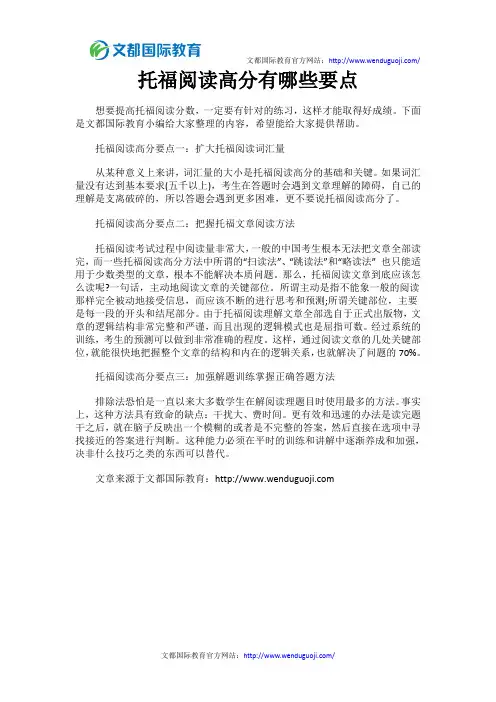
文都国际教育官方网站:/托福阅读高分有哪些要点想要提高托福阅读分数,一定要有针对的练习,这样才能取得好成绩。
下面是文都国际教育小编给大家整理的内容,希望能给大家提供帮助。
托福阅读高分要点一:扩大托福阅读词汇量从某种意义上来讲,词汇量的大小是托福阅读高分的基础和关键。
如果词汇量没有达到基本要求(五千以上),考生在答题时会遇到文章理解的障碍,自己的理解是支离破碎的,所以答题会遇到更多困难,更不要说托福阅读高分了。
托福阅读高分要点二:把握托福文章阅读方法托福阅读考试过程中阅读量非常大,一般的中国考生根本无法把文章全部读完,而一些托福阅读高分方法中所谓的“扫读法”、“跳读法”和“略读法” 也只能适用于少数类型的文章,根本不能解决本质问题。
那么,托福阅读文章到底应该怎么读呢?一句话,主动地阅读文章的关键部位。
所谓主动是指不能象一般的阅读那样完全被动地接受信息,而应该不断的进行思考和预测;所谓关键部位,主要是每一段的开头和结尾部分。
由于托福阅读理解文章全部选自于正式出版物,文章的逻辑结构非常完整和严谨,而且出现的逻辑模式也是屈指可数。
经过系统的训练,考生的预测可以做到非常准确的程度。
这样,通过阅读文章的几处关键部位,就能很快地把握整个文章的结构和内在的逻辑关系,也就解决了问题的70%。
托福阅读高分要点三:加强解题训练掌握正确答题方法排除法恐怕是一直以来大多数学生在解阅读理题目时使用最多的方法。
事实上,这种方法具有致命的缺点:干扰大、费时间。
更有效和迅速的办法是读完题干之后,就在脑子反映出一个模糊的或者是不完整的答案,然后直接在选项中寻找接近的答案进行判断。
这种能力必须在平时的训练和讲解中逐渐养成和加强,决非什么技巧之类的东西可以替代。
文章来源于文都国际教育:文都国际教育官方网站:/。
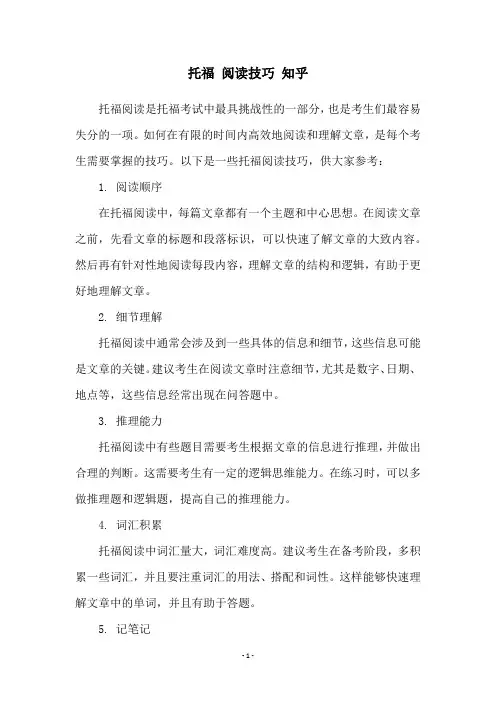
托福阅读技巧知乎
托福阅读是托福考试中最具挑战性的一部分,也是考生们最容易失分的一项。
如何在有限的时间内高效地阅读和理解文章,是每个考生需要掌握的技巧。
以下是一些托福阅读技巧,供大家参考:
1. 阅读顺序
在托福阅读中,每篇文章都有一个主题和中心思想。
在阅读文章之前,先看文章的标题和段落标识,可以快速了解文章的大致内容。
然后再有针对性地阅读每段内容,理解文章的结构和逻辑,有助于更好地理解文章。
2. 细节理解
托福阅读中通常会涉及到一些具体的信息和细节,这些信息可能是文章的关键。
建议考生在阅读文章时注意细节,尤其是数字、日期、地点等,这些信息经常出现在问答题中。
3. 推理能力
托福阅读中有些题目需要考生根据文章的信息进行推理,并做出合理的判断。
这需要考生有一定的逻辑思维能力。
在练习时,可以多做推理题和逻辑题,提高自己的推理能力。
4. 词汇积累
托福阅读中词汇量大,词汇难度高。
建议考生在备考阶段,多积累一些词汇,并且要注重词汇的用法、搭配和词性。
这样能够快速理解文章中的单词,并且有助于答题。
5. 记笔记
在阅读文章时,可以将文章的关键信息和自己的思考记录在本子上,这样有助于巩固记忆和理解文章。
考生可以根据自己的习惯,选择简短的词语或者符号来记录。
以上是一些托福阅读技巧的分享,希望能对大家有所帮助。
最后,提醒考生备考时要多做练习和模拟考试,熟悉考试形式和节奏,提高自己的托福阅读能力。
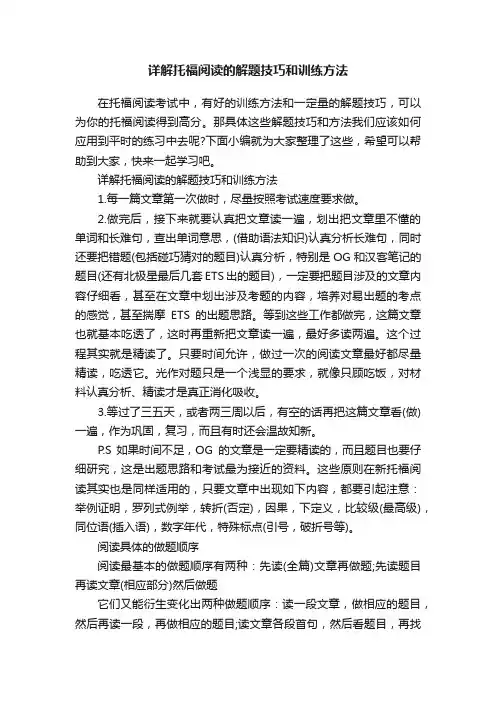
详解托福阅读的解题技巧和训练方法在托福阅读考试中,有好的训练方法和一定量的解题技巧,可以为你的托福阅读得到高分。
那具体这些解题技巧和方法我们应该如何应用到平时的练习中去呢?下面小编就为大家整理了这些,希望可以帮助到大家,快来一起学习吧。
详解托福阅读的解题技巧和训练方法1.每一篇文章第一次做时,尽量按照考试速度要求做。
2.做完后,接下来就要认真把文章读一遍,划出把文章里不懂的单词和长难句,查出单词意思,(借助语法知识)认真分析长难句,同时还要把错题(包括碰巧猜对的题目)认真分析,特别是OG和汉客笔记的题目(还有北极星最后几套ETS出的题目),一定要把题目涉及的文章内容仔细看,甚至在文章中划出涉及考题的内容,培养对易出题的考点的感觉,甚至揣摩ETS的出题思路。
等到这些工作都做完,这篇文章也就基本吃透了,这时再重新把文章读一遍,最好多读两遍。
这个过程其实就是精读了。
只要时间允许,做过一次的阅读文章最好都尽量精读,吃透它。
光作对题只是一个浅显的要求,就像只顾吃饭,对材料认真分析、精读才是真正消化吸收。
3.等过了三五天,或者两三周以后,有空的话再把这篇文章看(做)一遍,作为巩固,复习,而且有时还会温故知新。
P.S 如果时间不足,OG的文章是一定要精读的,而且题目也要仔细研究,这是出题思路和考试最为接近的资料。
这些原则在新托福阅读其实也是同样适用的,只要文章中出现如下内容,都要引起注意:举例证明,罗列式例举,转折(否定),因果,下定义,比较级(最高级),同位语(插入语),数字年代,特殊标点(引号,破折号等)。
阅读具体的做题顺序阅读最基本的做题顺序有两种:先读(全篇)文章再做题;先读题目再读文章(相应部分)然后做题它们又能衍生变化出两种做题顺序:读一段文章,做相应的题目,然后再读一段,再做相应的题目;读文章各段首句,然后看题目,再找文章内相应部分做题对于广大非牛来说,可能“读文章各段首句,然后看题目,再找文章内相应部分做题”会比较合适,读各段首句可以粗略掌握文章大意和结构,做题再看内容再做能大大降低“工作量”,但是这种做法不利于对全文的消化吸收,从而不利于做总结题,也可能会遗漏文章内的一些细节而导致做错细节题。
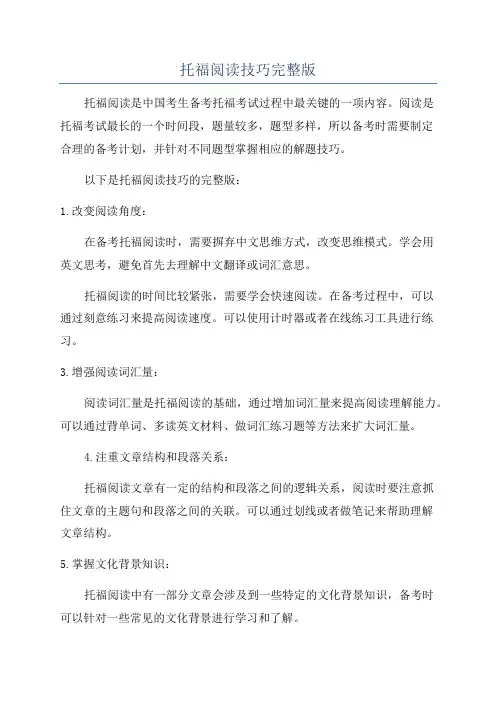
托福阅读技巧完整版托福阅读是中国考生备考托福考试过程中最关键的一项内容。
阅读是托福考试最长的一个时间段,题量较多,题型多样,所以备考时需要制定合理的备考计划,并针对不同题型掌握相应的解题技巧。
以下是托福阅读技巧的完整版:1.改变阅读角度:在备考托福阅读时,需要摒弃中文思维方式,改变思维模式。
学会用英文思考,避免首先去理解中文翻译或词汇意思。
托福阅读的时间比较紧张,需要学会快速阅读。
在备考过程中,可以通过刻意练习来提高阅读速度。
可以使用计时器或者在线练习工具进行练习。
3.增强阅读词汇量:阅读词汇量是托福阅读的基础,通过增加词汇量来提高阅读理解能力。
可以通过背单词、多读英文材料、做词汇练习题等方法来扩大词汇量。
4.注重文章结构和段落关系:托福阅读文章有一定的结构和段落之间的逻辑关系,阅读时要注意抓住文章的主题句和段落之间的关联。
可以通过划线或者做笔记来帮助理解文章结构。
5.掌握文化背景知识:托福阅读中有一部分文章会涉及到一些特定的文化背景知识,备考时可以针对一些常见的文化背景进行学习和了解。
7.多做阅读练习题:托福阅读题型多样,备考时需要多做不同类型的阅读练习题。
可以从官方教材、模拟试题集等练习材料中选择合适的题目进行练习。
8.制定备考计划:备考托福阅读需要制定合理的备考计划。
可以根据自己的时间和能力情况,合理安排每天的备考时间,并制定具体的备考目标。
9.多做模拟考试:模拟考试是检验备考成果的有效方法,可以通过模拟考试来检验自己的备考情况,并找出备考中的问题和不足之处。
可以选择一些官方的模拟试题或者在线模考平台进行练习。
10.注重综合能力培养:托福阅读考察的不仅仅是阅读理解能力,还需要发展综合能力,比如写作能力、逻辑思维能力等。
备考时可以多读英文原著、参加英语角等活动来提高综合能力。
以上就是托福阅读技巧的完整版。
希望以上内容对您备考托福阅读有所帮助!。
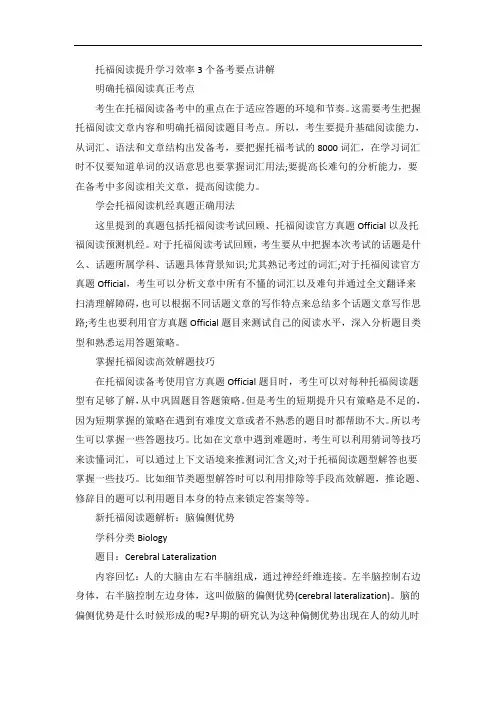
托福阅读提升学习效率3个备考要点讲解明确托福阅读真正考点考生在托福阅读备考中的重点在于适应答题的环境和节奏。
这需要考生把握托福阅读文章内容和明确托福阅读题目考点。
所以,考生要提升基础阅读能力,从词汇、语法和文章结构出发备考,要把握托福考试的8000词汇,在学习词汇时不仅要知道单词的汉语意思也要掌握词汇用法;要提高长难句的分析能力,要在备考中多阅读相关文章,提高阅读能力。
学会托福阅读机经真题正确用法这里提到的真题包括托福阅读考试回顾、托福阅读官方真题Official以及托福阅读预测机经。
对于托福阅读考试回顾,考生要从中把握本次考试的话题是什么、话题所属学科、话题具体背景知识;尤其熟记考过的词汇;对于托福阅读官方真题Official,考生可以分析文章中所有不懂的词汇以及难句并通过全文翻译来扫清理解障碍,也可以根据不同话题文章的写作特点来总结多个话题文章写作思路;考生也要利用官方真题Official题目来测试自己的阅读水平,深入分析题目类型和熟悉运用答题策略。
掌握托福阅读高效解题技巧在托福阅读备考使用官方真题Official题目时,考生可以对每种托福阅读题型有足够了解,从中巩固题目答题策略。
但是考生的短期提升只有策略是不足的,因为短期掌握的策略在遇到有难度文章或者不熟悉的题目时都帮助不大。
所以考生可以掌握一些答题技巧。
比如在文章中遇到难题时,考生可以利用猜词等技巧来读懂词汇,可以通过上下文语境来推测词汇含义;对于托福阅读题型解答也要掌握一些技巧。
比如细节类题型解答时可以利用排除等手段高效解题,推论题、修辞目的题可以利用题目本身的特点来锁定答案等等。
新托福阅读题解析:脑偏侧优势学科分类Biology题目:Cerebral Lateralization内容回忆:人的大脑由左右半脑组成,通过神经纤维连接。
左半脑控制右边身体,右半脑控制左边身体,这叫做脑的偏侧优势(cerebral lateralization)。
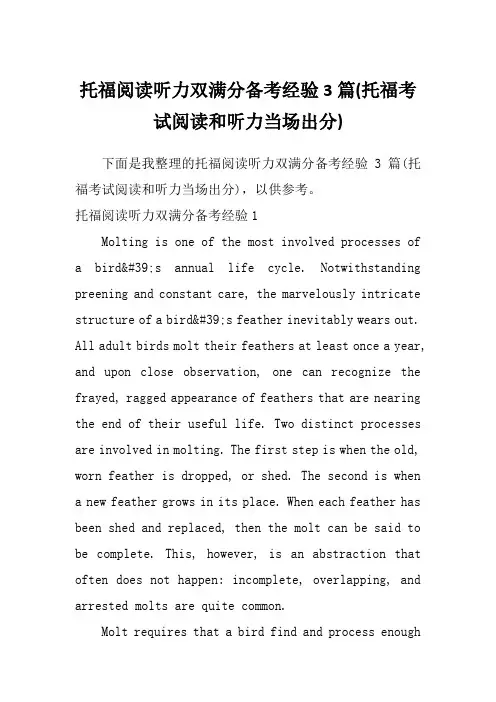
托福阅读听力双满分备考经验3篇(托福考试阅读和听力当场出分)下面是我整理的托福阅读听力双满分备考经验3篇(托福考试阅读和听力当场出分),以供参考。
托福阅读听力双满分备考经验1Molting is one of the most involved processes of a bird's annual life cycle. Notwithstanding preening and constant care, the marvelously intricate structure of a bird's feather inevitably wears out. All adult birds molt their feathers at least once a year, and upon close observation, one can recognize the frayed, ragged appearance of feathers that are nearing the end of their useful life. Two distinct processes are involved in molting. The first step is when the old, worn feather is dropped, or shed. The second is when a new feather grows in its place. When each feather has been shed and replaced, then the molt can be said to be complete. This, however, is an abstraction that often does not happen: incomplete, overlapping, and arrested molts are quite common.Molt requires that a bird find and process enoughprotein to rebuild approximately one-third of its body weight. It is not surprising that a bird in heavy molt often seems listless and unwell. But far from being random, molt is controlled by strong evolutionary forces that have established an optimal time and duration. Generally, molt occurs at the time of least stress on the bird. Many songbirds, for instance, molt in late summer, when the hard work of breeding is done but the weather is still warm and food still plentiful. This is why the woods in late summer often seem so quiet, when compared with the exuberant choruses of spring.Molt of the flight feathers is the most highly organized part of the process. Some species, for example, begin by dropping the outermost primary feathers on each side (to retain balance in the air) and wait until the replacement feathers are about one-third grown before shedding the next outermost, and so on. Others always start with the innermost primary feathers and work outward. Yet other species begin in the middle and work outward on both sides. Most ducks shed their wing feathers at once, and remain flightless for two or three weeks while the replacement feathersgrow.1. The passage mainly discusses how(A) birds prepare for breeding(B) bird feathers differ from species(C) birds shed and replace their feathers(D) birds are affected by seasonal changes2. The word Notwithstanding in line 2 is closest in meaning to(A) despite(B) because of(C) instead of(D) regarding3. The word intricate in line 2 is closest in meaning to(A) regular(B) complex(C) interesting(D) important4. The word random in line 12 is closest in meaning to(A) unfortunate(B) unusual(C) unobservable(D) unpredictable5. The word optimal in line 13 is closest in meaning to(A) slow(B) frequent(C) best(D) early6. Which of the following is NOT mentioned as a reason that songbirds molt in the late summer?(A) Fewer predators are in the woods.(B) The weathers are still warm.(C) The songbirds have finished breeding.(D) Food is still available.7. Some birds that are molting maintain balance during flight by(A) constantly preening and caring for their remaining feathers(B) dropping flight feathers on both sides at the same time(C) adjusting the angle of their flight to compensate for lost feathers(D) only losing one-third of their feathers8. The word Others in line 21 refers to(A) ducks(B) sides(C) species(D) flight feathers9. The author discusses ducks in order to provide an example of birds that(A) grow replacement feathers that are very long(B) shed all their wing feathers at one time(C) keep their innermost feathers(D) shed their outermost feathers first10. It can be inferred from the discussion about ducks that the molting of their flight feathers takes(A) a year(B) a season(C) several months(D) a few weeksPASSAGE 62 CABDC ABCBD托福阅读听力双满分备考经验2首先我为大家来晒一上该考生的托福考试成绩:阅读:30分、听力:30分、口语:22分、写作:28分。
How to Improve Your Reading Speed: Use My Techniques and Follow These Easy DirectionsINTRODUCTIONIn this newsletter, I'm going to show you some speed reading techniques that I've discovered to be extremely effective. There are three parts to today's newsletter, and I urge you to read each one very carefully.Part of my philosophy is that it's easier to learn something right the first time, than learn it wrong and try to correct yourself later. I learned speed reading wrong the first time, and it took me a long time to correct all of my problems. Luckily for you, that's given me good insight into all the things that can go wrong, and a vast knowledge of what works and what doesn't.So you're going to learn a bit about that here, and you're also going to get some easy‐to‐follow directions on a good speed reading method to try. Hopefully,you'll be able to take these tips and techniques and apply them to your normal reading routine. This stuff will work especially well if you've already "internalized" the tips and techniques from the previous newsletters, but even if this is the only thing you really pay attention to, I think you'll still make some great improvements to your reading ability.PART 1: REGRESSIONRegression is one of the biggest bad habits that slows people down when reading – and you know what worst part about it is? It's hard to tell if you're even doing it.Regression is the habit of skipping back while reading to re‐read something. When you do it intentionally, it's probably for a good reason. When you lose focus and stop following the material, then yeah, it's probably a good idea to skip back to where you lost track, and restart from there. But you'd be surprised at how often regression occurs unnecessarily. For a lot of people, regression is such a huge problem that as soon as they get it solved, their reading speed goes up by 100wpm.There are two ways to solve this problem. The first way is just to tell yourself to not regress. This actually helps a lot. Once you start to pay attention to yourregression, you'll notice how often you do it, and how often it's actually unnecessary.The second way is to actually help your eyes avoid regression, and this is what I'm going to show you how to do in this report.The reason we approach it this way is that a lot of the time, regression is not caused by loss of focus, or weak comprehension – it's just because your eyes are not very good at reading. I know this sounds a little strange, but it's truer than you think.It is extremely common people to "lose track" while reading. This happens all the time, in all kinds of ways, for almost all readers on the planet. For example, maybe your brain will just stop concentrating on the text, and your comprehension will start to drop off. Or maybe you'll actually lose your place while reading, and you'll have to scan around the page to find out where you left off. Here's another example: if you wanted to count something – like the number of lines on a page – how well do you think it would work if you just used your eyes (without a finger or a pencil to help you along)? Obviously, it wouldn't work very well – your eyes aren't very good at that kind of stuff.What your eyes ARE good at is darting around, scanning, and following motion. So the solution is to simply incorporate those things into reading, to make it a more enjoyable, more exciting experience for your eyes. (I know that your eyes are not sentient – I'm really talking about the vision centres of your brain, but it's easier to just say "eyes.")SO HERE'S THE SOLUTION:Focus Point Guiding. This is actually the basis of a few of the famous speed reading programs, like Eye Q, Howard Berg's "Mega Speed Reading", and a few more. The reason this is so popular is that it WORKS!Creating a focus point will help you guide your eyes, making sure that they read in exactly the way you want them to AND making it easy for them to read in exactly the way you want them to. So let me explain what exactly Focus Point Guiding is, so that you can know what I'm talking about here.The idea is to guide your eyes with your finger, or a pencil, (or whatever,) as you read. So if you're doing left‐to‐right reading, then you just go along with your finger where you think your eyes should be looking. Just underline the words as you read, and let your eyes pretty much follow your finger.Take a look at this diagram for a little visual explanation:This image was actually taken straight from the SpeedReading Manual, which talks about this same sort of stuff,but in more detail…Key points to remember: keep a steady rhythm, don't slow down, read as fast as your comprehension allows, and don't skip back.So let me tell you why this helps. When you guide your eyes with your finger, a few things happen:Your reading speed will become more stable.Your eyes will have an easier time keeping track of the text.You won't regress nearly as much.Your reading speed will increase.Those are all good things, and they work with each other to strengthen your reading ability as a whole.So that's all great, but how would you like to use that very same "focus point guiding" method to improve your reading speed even more, and give yourself an even bigger reading speed boost?Introducing…PART 2: THE "RUN/WALK" METHODThis technique involves alternating reading extremely quickly (running) and reading at your regular speed (walking). I got the "Run/Walk" name from marathon runners, who use this method to stretch out their endurance and travel extremely long distances.I find that this works extremely well in reading, but only if you do it right. So right now, I'm going to show you how to do it right, and how to use this method to drastically improve your reading ability.WAIT! This method makes heavy use of focus point guiding. It's a verygood idea to practice that up a little bit before trying this. If you want tomake some big progress using the run/walk method, then I seriouslyrecommend that you pause reading here, get a book or a newspaper, and read at least one article or one chapter using your finger to pace andguide your eyes. Focus point guiding is a core part of the run/walkmethod, so you need to be comfortable with it before continuingFirst let's define the "walk" in this method. Walking is reading at your best, most comfortable speed. It's the speed where your comprehension is at 100%, and where if you go any faster, your comprehension starts to drop. If you've got a page of text handy, then try reading a paragraph or two in your walk speed (remember to guide your focus point), and remind yourself of how fast that is. Your "run" speed should be way faster than your walk. If your walk speed is around 250wpm, then your run should be 750wpm – aim for triple your walk speed. It's at this super‐speed that focus point guiding is going to become useful in a very obvious, very observable way. If you try to read at this kind of speedwithout guiding your focus point, you'll find that it's almost impossible to keep track of the text… But when you've got your finger underlining every word, and your eyes working to follow the finger and not fall behind, it's a whole different game.Your comprehension at your "run" speed should be very low. But that doesn't mean you shouldn't pay attention to the text. What you want to do is try your hardest to catch as many words as you can. It will feel like you're flying by the text, and only picking out a few words as they pass by, but that's the point.When "running", something very interesting is going to happen… Your eyes will begin to adapt to the new speed. Your eyes will get better at recognizing and identifying the words, and your comprehension will slowly start to increase.And that right there is the crucial piece of information – your comprehension will increase even if you don't slow down. It's probably BECAUSE you don't slow down. What you're doing is presenting your eyes with information input at a faster speed than they're used to. The mistake that most people make in this sort of situation is to adapt their behaviour for their eyes. All you need to do is let your eyes adapt for your behaviour.If your comprehension at 600wpm is 5% today, it can increase to 10% tomorrow – BUT ONLY IF YOU PRACTICE READING AT 600WPM. Let your eyes adapt. You just need to give them some time and practice, and they will.So here's how to do the run/walk method: read for 2 full minutes in run speed (use a timer!), take a quick break, then read for 2 full minutes in walk speed. Then start again: run, walk; run, walk.The results of "Run/Walk" as a reading method are even more significant than they are as a marathon running method. Every time you complete that run/walk cycle, your "run" will increase in comprehension, and your "walk" will get a little faster. And it's that second result that's actually the most exciting. Remember that your "walk" is the speed where comprehension is 100% – so that's the one that really matters.This method blew my mind when I first tried it on my own. Most people never even try to "run". They might just do it for a second, but then say "oh what's thepoint! I can't comprehend anything at this speed anyway." What they don't realize is that "running" challenges your eyes, and demands them to improve and adapt to a new speed.PART 3: READ 15 MINUTES A DAYThe benefits of practice can never be overstated. Practicing reading will improve your vocabulary, increase your comfort with the material, quicken your rational‐thought processes, and a whole lot more.Think about how much some people are able to improve WITHOUT any help, when all they do is read a ton of books. In your situation, with all of these tried & tested tips sent to your inbox every couple of days, and with all of the other resources you have on the internet, think about how much YOU can improve, just by practicing a little bit every day.If you're not doing so already, then from now on try to set aside at least half an hour every day for pure un‐interrupted READING. You can read anything you want ‐‐ the point is that you spend that full half‐hour practicing the techniques you've learned.If you spend 30 minutes a day (starting today) reading with focus point guiding, the run/walk method, and a few of those other tips you learned in the other newsletters, I think that within the week you will start to notice some significant improvements in your reading ability.But maybe you don't have 30 minutes a day to spend on reading… So let's say you only have a maximum of 15 minutes to spend per day. Let's do a bit of math, and see how much those 15 minutes can help you in the long run.If your reading speed is 200wpm (a full 50wpm below the average reading speed), and if you read for 15 minutes every day 350 days a year (taking 15 days off for whatever reason), by the end of the year you will have read FIFTEEN BOOKS.That means that every minute you spend reading per day equals a whole book finished by the end of a year. If you read 20 minutes a day, you'll read 20 books. If you read 30 minutes a day, you'll read 30 books.And don't forget, that's at the meager reading speed of 200wpm. The average reading speed is 250wpm, and the fact that you're reading this probably means that your reading speed is getting at least a little faster than that…So think about it: how many books did you read last year? More than 15? If so, great. For most people, that's not the case. But either way, you should be ADDING these 15 minutes onto your current reading schedule. You should always be reading more and more.At this point in my reading ability, I'm reading a few books every week. A couple times a month, I go to my University library, and get a new load of books to read. Getting to that level is actually easier than you think. I did spend a few years getting there myself, but I was making all kinds of silly mistakes and I didn't really have a very good idea of what I was doing.You, right now, have an enormous advantage. You have access to some of the best, most reliable speed reading tips that I've ever learned – during my huge long training period, I picked up a huge amount of knowledge on this stuff, andI'm happy to share it all with you. My goal here is not just to teach you how to speed read, but to save you all of the time‐consuming trouble that I went through when I learned how to speed read.The techniques that I'm showing you in these newsletters are really just the tip of the iceberg. I have so much more – so many powerful techniques, and so much valuable information – that I can't possibly share it all in these short newsletters.If you want access to my full speed reading system, with step‐by‐step methods for reading with maximum speed and maximum comprehension, then check out my Speed Reading Manual.You can find it right here:Click Here for the Speed Reading ManualI changed the deal recently, so if you haven't gone to see it, I recommend you do so now. I put up an offer that I don't think anyone can refuse. Check it out and see what I mean. I think you'll be surprised.The book is available for instant download, so you can download it to your computer an start studying from it right away… and it's got pretty much all of the best speed reading techniques that I know packed into just 40 pages.If you don't see amazing improvements in your reading ability within the first 7 days of using the book, you won't have to pay a dime. Your satisfaction is 100% guaranteed. Click here and see what I mean:Click Here for the Speed Reading ManualI'll do my best to keep this newsletter going, and I know you'll keep an eye out for my emails. I really hope you click on that blue link above – I think you'll like what you find on the other side.Thanks,StephenIMPORTANT LEGAL INFORMATION: The specific improvements that I mention in this report are not typical results. You may be less successful or more successful. I am not in any way implying that everyone who reads this report, follows my advice, or buys any product will improve their reading speed, or gain any benefits whatsoever. To my knowledge, there isn't a product in the world that works that well. Learning how to speed read involves practice, and training. And sometimes, no matter how hard you try, you don't get the results you expect. So please, don’t take any mention of my success or the success of an associate as a promise or implication of your future results.。
托福阅读技巧
托福阅读是托福考试中最为重要的一部分,也是许多考生最为头疼的一部分。
在托福阅读中,考生需要在规定时间内阅读三篇文章,并回答相关问题。
为了帮助考生更好地应对托福阅读,以下是一些托福阅读技巧。
1. 阅读前预览
在阅读文章之前,考生应该先预览文章的标题、段落标题、图片和图表等内容,以便更好地理解文章的主题和结构。
这样可以帮助考生更快地找到文章中的重点和关键信息。
2. 理解文章结构
托福阅读文章通常都有一个明确的结构,包括引言、主体和结论等部分。
考生应该学会识别这些部分,并理解它们之间的关系。
这样可以帮助考生更好地理解文章的主旨和论点。
3. 注意关键词
在阅读文章时,考生应该注意文章中的关键词和短语,这些词汇通常是文章的重点和关键信息。
考生可以在阅读时用笔或者标记工具标记这些关键词,以便在回答问题时更快地找到答案。
4. 理解文章语境
托福阅读文章中常常会出现一些生词和难懂的句子,考生应该学会通过上下文来理解这些词汇和句子的含义。
同时,考生也应该注意文章中的逻辑关系和转折点,以便更好地理解文章的意思。
5. 练习阅读速度
托福阅读时间紧张,考生需要在规定时间内阅读完三篇文章,并回答相关问题。
因此,考生应该在平时练习中提高阅读速度,同时也要保持阅读准确性和理解能力。
托福阅读是一项需要技巧和实践的考试,考生应该在平时多加练习,提高阅读速度和理解能力,同时也要注意文章结构和关键词,以便更好地应对托福阅读考试。
托福阅读别看技巧了!这两点你做到没很多同学刚开始复习托福阅读的时候,比较专注于托福阅读技巧练习。
找关键词、关键句之类的,小编觉得托福阅读需要掌握一定技巧,但好像本末倒置了。
才刚开始复习,不应该要好好提升托福阅读能力吗?那么托福阅读能力又该怎样提高呢?下面和小编一起看看吧!托福阅读别看技巧了!这两点你做到没?一、托福阅读看词汇我给自己定的托福阅读目标是100分,但是第一次做真题下来,分数简直惨不忍睹!这可怎么是好?在阅读训练中,我发现词汇很多不认识,大大影响阅读速度和理解,所以我觉得词汇量真的是很重要的因素。
我大学四级才440分的水平,基本就没什么词汇量。
所以我开始沉下心来准备背单词征程,虽然这个过程中冗长且乏味。
我一共啃了两本单词书:大学四级单词新东方和托福单词21天。
乱序版的大学四级单词新东方背了7遍,呵呵,可想而知我有多熟。
把书扔掉的时候很多书页已经烂了。
托福单词21天背了4遍,不认识的单词,能够通过单词的长相词根词缀等准确的猜出单词的意思。
最后是一些分类词汇也间歇的看了一下。
觉得词汇量有着长足的进步。
二、托福阅读遇到长难句怎么办?托福阅读中遇到长难句子基本就懵比,是不是你的写照。
而且长难句的运用穿插在托福阅读十大题型中的任何一类,它不仅与句子简化题息息相关,更与细节题、推断题、修辞目的题等其它题型相扣。
而且看不懂长难句,无法迅速抓住这个句子的重点,托福阅读基本就死,就算答案定位准确了,也无法做对题目。
三、托福阅读如何练习看懂长难句(1)找到合适的长难句+拆解/翻译练习语法较规整且有很多的变化的长难句最适合用来做练习,接下来,就是做最基本的长句拆解翻译练习。
长句如何拆解,这个说起来挺复杂的,可以关注我们公众号:就爱说英语,会有相关资料推送。
(2)有一定逻辑、语法基础之后,可以去练习句子简化题。
(3)使用阅读文章中长的段落,进行上下文练习,这时的练习不仅仅包括对单个长难句的理解,还包括对段落特征词、功能词的理解,段落结构的理解。
toefl junior 阅读
想要提高托福 Junior 阅读水平,可以参考以下方法:
- 积累词汇:通过眼看、耳听、口说、手写等多种方式结合语境来记忆词汇。
- 精读练习:在刚开始接触阅读部分时,可以先注重每篇文章的阅读质量,除了做题以外,还要花时间做通篇的复盘精读,弄懂文中每个单词和短语的含义,准确理解每个句子的意思以及梳理文章展开的方式。
- 泛读补充:除了做TOEFL Junior 的练习题以外,学生在备考时也可以选择其他阅读材料进行泛读。
托福 Junior 阅读部分难度跨度较大,建议通过多加练习来提高阅读能力。
托福高分心得之阅读成绩如何快速提高托福阅读的满分30,同学备考在阅读上花的时间不少,分数却并不理想。
很多同学想知道那些阅读高分是如何拿到的,别急,下面就和大家分享托福高分心得,来欣赏一下吧。
一. 阅读速度一定要提高提高速度好像并没不是什么有用的技巧,但是其实却有极强的指导意义。
不过这里必须强调的是,这里是在保证正确率的情况下提升我们的做题速度,而不是用所谓的关键词解题法,随便看几个关键词就做题了,这里面所要求的提高做题速度,是通过我们通过看美剧,通过翻译官方真题Official阅读文章等方法,强化我们对于英语本身语言组织能力,或者说理解能力。
二.大量练习,题海战术还记得高中的题海战术吗?是的,题海战术对于托福阅读的提升是很有效的。
只有到这个时候,官方真题Official题海战术对于我们来说才是有意义的,我们要通过海量的做题,提升我们的理解能力,检验我们的语法体系细节的问题,同时帮助我们掌握对于出题的固有思路的习惯。
这是除summary与单词题之外的题型抢分的关键。
三.不该错的题保证不做错阅读考试完以后,很多同学都会说,很多题会做的,做错了,但是已经考完试了,再说会做有什么用呢?避免不该错的题会让我们成绩得到明显提升。
考试中一定要看准题目和选项,不要做错本来不该错的题,这个点的把握其实并不容易。
阅读的速度很快,要再快速做题的过程中避免这类错误需要大家在平时的练习中多注意。
Paragraph4: As the demand for agricultural produce from both consumers and industry increased, agricultural land became more valuable and people tried to work the available land moreintensively and to reclaim more land from wetlands and lakes. In order to increase productionon existing land, the peasants made more use of crop rotation and, in particular, began toapply animal waste to the soil regularly, rather than leaving the fertilization process up to thegrazing livestock. For the first time industrial waste, such as ash from the soap-boilers, wascollected in the cities and sold in the country as artificialfertilizer. The increased yield andprice of land justified reclaiming and draining even more land.段落四:随着消费者和工业对这种农产品的需求增加,耕地变得越来越珍贵,人们对可耕地的利用强度越来越大,并且从湿地和湖泊中开垦了更多的耕地。
为了增加已有土地的产量,农民们利用谷物轮作,特别是用动物粪便来给土地定期施肥而不是随意让牧区的牲畜来进行施肥。
城市首次收集工业废料, 比如煮皂的灰料和城市废料,并作为人工肥料售给乡下。
产量的增加和土地价格的上涨使得开垦和灌溉更多的土地变得合理化。
7.Select the TWO answer choices that, aording to paragraph 4, indicate two methodspeople used to increase the productivity of their land. To receive credit you must select TWO answersA.They planted different crops in different sections of the farm each year.B.They used improved irrigation methods to increase the yield of crops.C.They increased the use of fertilizers to supply more nutrients to plants.D.They used new horticultural practices to produce different varieties of plants in the samesection of the farm.这道题目选AC。
首先C选项很容易从文中找到答案C选项原文出处:began toapply animal waste to the soil regularly, rather than leaving the fertilization process up to the grazing livestock.C选项出处释义:用动物粪便来给土地定期施肥而不是随意让牧区的牲畜来进行施肥。
但是A选项似乎就没那么简单被选出来了,因为它牵扯到了一个常识。
A选项原文出处:In order to increase productionon existing land, the peasants made more use of crop rotationA选项出处释义:为了增加已有土地的产量,农民们利用谷物轮种。
但是对应到A选项They planted different crops in different sections of the farm each year后,怎么感觉说的不是一回事儿呢。
好啦,那接下来我们给大家解释一个概念,就自然清楚了—谷物轮种(Crop rotation)。
介绍在同一块田地上,有顺序地在季节间或年间轮换种植不同的作物或复种组合的一种种植方式。
轮作是用地养地相结合的一种生物学措施。
中国早在西汉时就实行休闲轮作。
北魏《齐民要术》中有“谷田必须岁易”、“麻欲得良田,不用故墟”、“凡谷田,绿豆、小豆底为上,麻、黍、故麻次之,芜菁、大豆为下”等记载,已指出了作物轮作的必要性,并记述了当时的轮作顺序。
长期以来中国旱地多采用以禾谷类为主或禾谷类作物、经济作物与豆类作物的轮换,或与绿肥作物的轮换,有的水稻田实行与旱作物轮换种植的水旱轮作。
作用合理的轮作有很高的生态效益和经济效益:防治病、虫、草害作物的许多病害如烟草的黑胫病、蚕豆根腐病、甜菜褐斑病、西瓜蔓割病等都通过土壤侵染。
如将感病的寄主作物与非寄主作物实行轮作,便可消灭或减少这种病菌在土壤中的数量,减轻病害。
对为害作物根部的线虫,轮种不感虫的作物后,可使其在土壤中的虫卵减少,减轻危害。
合理的轮作也是综合防除杂草的重要途径,因不同作物栽培过程中所运用的不同农业措施,对田间杂草有不同的抑制和防除作用。
如密植的谷类作物,封垄后对一些杂草有抑制作用;玉米、棉花等中耕作物,中耕时有灭草作用。
一些伴生或寄生性杂草如小麦田间的燕麦草、豆科作物田间的菟丝子,轮作后由于失去了伴生作物或寄主,能被消灭或抑制为害。
水旱轮作可在旱种的情况下抑制,并在淹水情况下使一些旱生型杂草丧失发芽能力。
均衡利用土壤养分各种作物从土壤中吸收各种养分的数量和比例各不相同。
如禾谷类作物对氮和硅的吸收量较多,而对钙的吸收量较少;豆科作物吸收大量的钙,而吸收硅的数量极少。
因此两类作物轮换种植,可保证土壤养分的均衡利用,避免其片面消耗。
调节土壤肥力谷类作物和多年生牧草有庞大根群,可疏松土壤、改善土壤结构;绿肥作物和油料作物,可直接增加土壤有机质。
另外,轮种根系伸长深度不同的作物,深根作物可以利用由浅根作物溶脱而向下层移动的养分,并把深层土壤的养分吸收转移上来,残留在根系密集的耕作层。
同时轮作可借根瘤菌的固氮作用,补充土壤氮素,如花生和大豆每亩可固氮6~8千克,多年生豆科牧草固氮的数量更多。
水旱轮作还可改变土壤的生态环境,增加水田土壤的非毛管孔隙,提高氧化还原电位,有利土壤通气和有机质分解,消除土壤中的有毒物质,防止土壤次生潜育化过程,并可促进土壤有益微生物的繁殖。
相信到此为止,大家应该非常了解什么叫做谷物轮种了,因此这道题的A选项也就变得没有那么可怕了吧!在考试时,像这样需要背景知识,却又在原文中没有铺垫背景知识的题目很少见,童鞋们不要害怕!只要耐心懂,认真看,即使碰到这样的题目猜一猜也是有很高几率做对的!同学们也许经常会发现好不容易背会单词可是做题却没有做对,同学们也会察觉明明选项里有原文的同义表达自己却傻傻没有认出来,同学们还会被单词的近义词或是同词根的相近词的变形蒙在鼓里,这里提到的这些问题时常困扰着大家,那么今天我们就来揭开它的神秘面纱,让大家在题海里游刃有余。
先来举个简单的例子,在阅读篇章当中The guitar, which is also known as the poor man‘s piano, has been cherished by many cultures. 这个句子中选出与这个句子最符合的选项时,大家一定需要注意正确选项Various cultures have enjoyed the guitar.中的同义转换情况。
我们一起来看一下究竟在哪里出现了同义情况:1.首先我们需要先提取句子主干,即:The guitarhas been cherished by many cultures. 2.其次我们来看选项中various这个词跟篇章中的many都有“多”的含义,cherish和enjoy都有珍惜享有之意,那么我们就需要格外关注这个选项。
3.最后我们发现该选项就是原文的被动句转主动句的同义改写,那么毋庸置疑,答案都应该是那句话的选项。
现在我们再来看一道托福题目,Which of the following can be inferred from paragraph 1 about early sea otters?于是我们定位到该题目的文章所在处However, unlike the cases of sea otters and pinnipeds (seals, sea lions, and walruses, whose limbs are functional both on land and at sea), it is not easy to envision what the first whales looked like. 1.首先我们要把逻辑理清楚,unlike A , it is not easy to do B,这样一来,不像A,做B是B不是简单的,那么,显而易见做A应该是简单的。